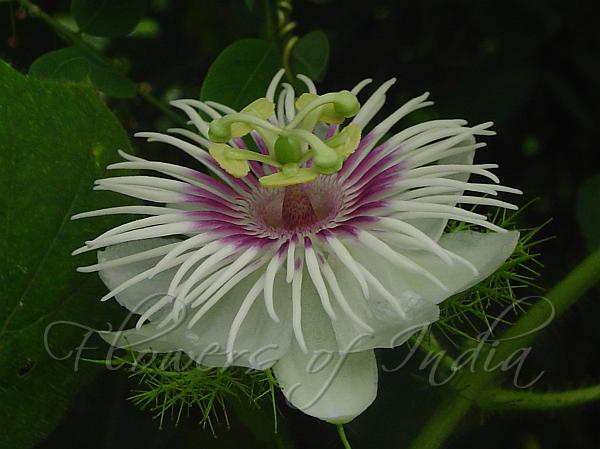|
| Love in a Mist |
|

|

| File size | 892702 |
| Original date | 4/2/08 7:16 AM |
| Resolution | 2048 x 1536 |
| Flash | Flash did not fire |
| Focal length | 6.3mm |
| Exposure time | 1/200s |
| Aperture | 3.8 |
| Focus Distance | |
| Metering Mode | Spot |
| Camera make | SONY |
| Camera model | DSC-P52 |
| Sensor type |
|
|
|
Photo: |
Botanical name: Passiflora vesicaria var. vesicaria Family: Passifloraceae (Passion flower family)
Synonyms: Passiflora foetida var. glabrifolia, Passiflora foetida var. hispida
Synonyms: Passiflora foetida var. glabrifolia, Passiflora foetida var. hispida
Love-in-a-mist is a creeping vine which has an edible fruit and leaves that
have a mildly rank aroma. It is native to northern South America and the West
Indies. The stems are thin, wiry and woody, covered with sticky yellow hairs.
The leaves are three- to five-lobed and viscid-hairy. They give off an
unpleasant odour when crushed. The flowers are white to pale cream coloured,
about 5-6 cm diameter.
Flower-cluster-stalks are 2-6 cm long,
Bracts are 2-4 cm long, increasing in size as fruit
develops, 2- or 3-piinately divided into gland
tipped segments, usually closely interwoven.
Flowers are white and mauve, 4.0-6.5 cm in diameter. Sepals are
ovate-lanceshaped or lanceshaped, 1.5-2.8 cm long, 0.6-1 cm wide,
Petals are oblong or lanceshaped, 1-2.5 cm long,
5-8 mm wide, thin-membranous, white on upper and lower surfaces. Corona
filaments are in 5-7 series, the outer two series 1-1.8 cm long,
thread-like, lower 1/3 to 1/2 part mauve or lilac, upper portion white,
inner 3-5 series erect, 1-3 mm high, getting shorter towards base,
white or white at base with mauve or lilac tip.
The fruit is globose, 1.5-3 cm diameter, yellowish-orange
to red when ripe, and has numerous black seeds embedded in the pulp; the fruit
are eaten and the seeds dispersed by birds.
Medicinal uses: This species can be helpful in treating digestive
problems, including dyspepsia and diarrhea; or used as an astringent and
expectorant for nervous conditions and spasms.
This species can be helpful in treating digestive
problems, including dyspepsia and diarrhea; or used as an astringent and
expectorant for nervous conditions and spasms.
Medicinal uses:
 This species can be helpful in treating digestive
problems, including dyspepsia and diarrhea; or used as an astringent and
expectorant for nervous conditions and spasms.
This species can be helpful in treating digestive
problems, including dyspepsia and diarrhea; or used as an astringent and
expectorant for nervous conditions and spasms.| Identification credit: V. Ashwini, Dinesh Valke | Photographed in Uran, Maharashtra. |
• Is this flower misidentified? If yes,